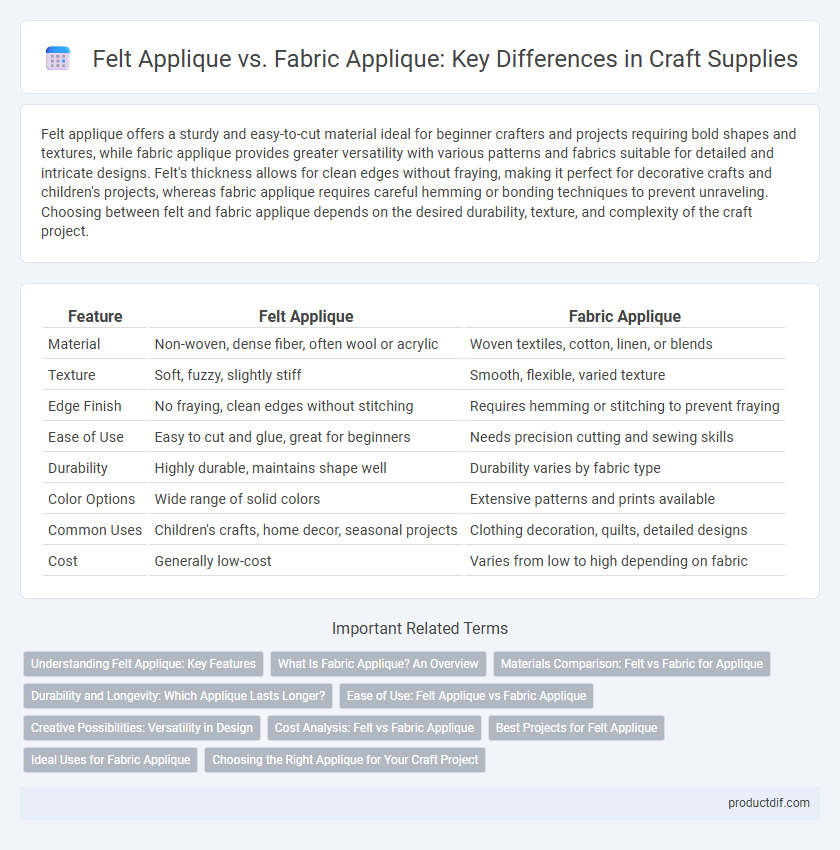Felt applique offers a sturdy and easy-to-cut material ideal for beginner crafters and projects requiring bold shapes and textures, while fabric applique provides greater versatility with various patterns and fabrics suitable for detailed and intricate designs. Felt's thickness allows for clean edges without fraying, making it perfect for decorative crafts and children's projects, whereas fabric applique requires careful hemming or bonding techniques to prevent unraveling. Choosing between felt and fabric applique depends on the desired durability, texture, and complexity of the craft project.
Table of Comparison
| Feature | Felt Applique | Fabric Applique |
|---|---|---|
| Material | Non-woven, dense fiber, often wool or acrylic | Woven textiles, cotton, linen, or blends |
| Texture | Soft, fuzzy, slightly stiff | Smooth, flexible, varied texture |
| Edge Finish | No fraying, clean edges without stitching | Requires hemming or stitching to prevent fraying |
| Ease of Use | Easy to cut and glue, great for beginners | Needs precision cutting and sewing skills |
| Durability | Highly durable, maintains shape well | Durability varies by fabric type |
| Color Options | Wide range of solid colors | Extensive patterns and prints available |
| Common Uses | Children's crafts, home decor, seasonal projects | Clothing decoration, quilts, detailed designs |
| Cost | Generally low-cost | Varies from low to high depending on fabric |
Understanding Felt Applique: Key Features
Felt applique offers a non-fraying texture due to its dense, pressed fibers, making it ideal for detailed crafting and easy layering. Unlike fabric applique, felt does not require hemming or edge finishing, simplifying the application process for intricate designs. Its stiffness and durability provide excellent stability, ensuring shapes maintain their form over time in various craft projects.
What Is Fabric Applique? An Overview
Fabric applique involves sewing fabric pieces onto a larger fabric surface to create decorative designs, often using a variety of textiles like cotton, silk, or denim for texture and color contrast. Unlike felt applique, fabric applique requires careful stitching techniques such as satin stitching or raw edge applique to secure and enhance the design's durability and appearance. This method offers versatility in patterns and complexity, making it popular for quilts, clothing embellishments, and home decor projects.
Materials Comparison: Felt vs Fabric for Applique
Felt applique offers a sturdy, non-fraying material ideal for bold shapes and easy layering, while fabric applique provides a broader range of textures and patterns, allowing for intricate designs and a softer finish. Felt's thickness ensures stability in smaller projects and quick, clean-cut edges, whereas fabric requires edge finishing methods like raw-edge, turned-edge, or blanket stitching to prevent unraveling. Choosing between felt and fabric hinges on project requirements for durability, detail, and the desired tactile effect in craft supply applications.
Durability and Longevity: Which Applique Lasts Longer?
Felt applique offers superior durability due to its dense fiber structure, resisting fraying and maintaining shape over time better than fabric applique. Fabric applique, while more versatile in texture and pattern, often requires additional stabilizers to prevent wear and tear, potentially reducing its lifespan. Choosing felt applique ensures longer-lasting crafts with minimal maintenance, ideal for projects needing enhanced longevity.
Ease of Use: Felt Applique vs Fabric Applique
Felt applique offers superior ease of use compared to fabric applique due to its stiff texture, which eliminates the need for edge finishing and prevents fraying. Fabric applique requires additional steps such as hemming or using fusible web to secure edges, increasing complexity for beginners. The simplicity of felt makes it ideal for quick, clean projects with minimal preparation.
Creative Possibilities: Versatility in Design
Felt applique offers a sturdy, textured surface ideal for bold, dimensional designs with ease of cutting and layering, making it perfect for intricate patterns and vibrant color contrasts. Fabric applique provides greater flexibility with various fabric weights and patterns, allowing for subtle shading, blending, and more detailed or realistic artistic effects. Both methods expand creative possibilities, with felt suited for playful, tactile projects and fabric enabling sophisticated, nuanced compositions.
Cost Analysis: Felt vs Fabric Applique
Felt applique offers a cost-effective option due to its lower price per yard and minimal fraying, reducing the need for hemming or finishing. Fabric applique, while potentially more expensive, provides greater variety in texture and pattern, which may justify the higher cost for detailed or decorative projects. Considering project scale and desired aesthetics helps determine the most economical choice between felt and fabric applique materials.
Best Projects for Felt Applique
Felt applique excels in projects requiring sturdy, non-fraying edges such as children's toys, decorative wall hangings, and personalized accessories due to its thick texture and ease of cutting. Unlike fabric applique, felt does not require hemming, making it ideal for intricate designs and layered effects in embroidery, holiday ornaments, and applique art quilts. Its durability and vibrant color retention make felt the preferred choice for beginner-friendly crafts and long-lasting, tactile projects.
Ideal Uses for Fabric Applique
Fabric applique is ideal for creating detailed and durable designs on clothing, home decor, and quilts due to its flexibility and range of textures. It works well for projects that require washable and soft finishes, making it perfect for apparel and baby items. The diverse fabric choices allow for intricate patterns and smooth edges, enhancing the visual appeal of sophisticated craft projects.
Choosing the Right Applique for Your Craft Project
Felt applique offers a sturdy, non-fraying material ideal for bold, textured designs, making it perfect for children's crafts and quick projects. Fabric applique provides greater versatility with diverse patterns and colors, suited for detailed, layered designs requiring precise stitching. Selecting between felt and fabric applique depends on the desired durability, complexity, and visual effect of your craft project.
Felt applique vs Fabric applique Infographic

 productdif.com
productdif.com